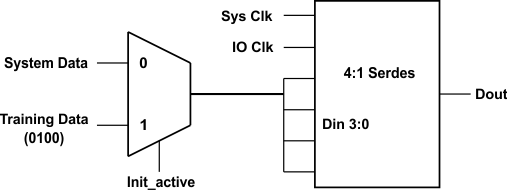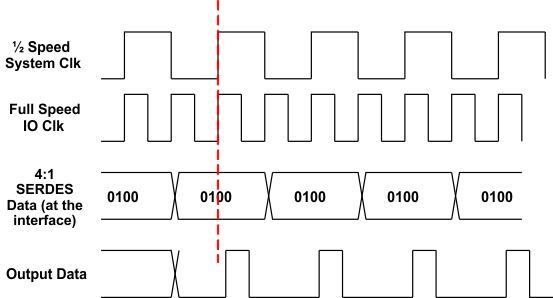ZHCSA85F August 2012 – February 2019 DLPC410
PRODUCTION DATA.
- 1 特性
- 2 应用
- 3 说明
- 4 修订历史记录
- 5 说明 (续)
- 6 Pin Configuration and Functions
- 7 Specifications
-
8 Detailed Description
- 8.1 Overview
- 8.2 Functional Block Diagrams
- 8.3
Feature Description
- 8.3.1
DLPC410 Binary Pattern Data Path
- 8.3.1.1 DIN_A, DIN_B, DIN_C, DIN_D Input Data Buses
- 8.3.1.2 DCLKIN Input Clocks
- 8.3.1.3 DVALID Input Signals
- 8.3.1.4 DOUT_A, DOUT_B, DOUT_C, DOUT_D Output Data Buses
- 8.3.1.5 DCLKOUT Output Clocks
- 8.3.1.6 SCTRL Output Signals
- 8.3.1.7 Supported DMD Bus Sizes
- 8.3.1.8 Row Cycle definition
- 8.3.1.9 DLP9500 and DLP9500UV Input Data Formatting
- 8.3.1.10 DLP7000 and DLP7000UV Input Data Bus
- 8.3.1.11 DLP650LNIR Input Data Bus
- 8.3.2 Data Bus Operations
- 8.3.3 DMD Block Operations
- 8.3.4 Other Data Control Inputs
- 8.3.5 Miscellaneous Control Inputs
- 8.3.6 Miscellaneous Status Outputs
- 8.3.1
DLPC410 Binary Pattern Data Path
- 8.4 Device Functional Modes
- 8.5 Programming
- 9 Application and Implementation
- 10Power Supply Recommendations
- 11Layout
- 12器件和文档支持
- 13机械、封装和可订购信息
8.4.1.2 input Data Interface (DIN) Training Pattern
The DLPC410 detects the phase differences between the ½ speed clock (used in the customer device driving the LVDS data) and the internally generated ½ speed data clocks and automatically corrects their alignment. This is done by the customer FPGA supplying a simple repeating pattern on all of the data inputs while the INIT_ACTIVE output of the DLPC410 is high/active. The details of the training pattern are described below.
This is a simple block diagram of the training pattern insertion logic.
 Figure 12. Block Diagram of Training Pattern Logic
Figure 12. Block Diagram of Training Pattern Logic The expected training pattern is 0100. In Figure 13 the data input to the 4:1 SERDES cells is captured on the rising edge of the ½ speed system clock. The output latency shown is based on the documentation for the Xilinx SERDES cells. Individual implementation may vary depending on the type of cells, technology, and design technique used.
 Figure 13. Training Pattern Alignment
Figure 13. Training Pattern Alignment NOTE
In Xilinx FPGAs (due to the construction of the ISERDES and OSERDES cells) a pattern of 0010 needs to be applied to the output/transmitting SERDES cells data pins (D1 = 0, D2 = 0, D3 = 1, D4 = 0) in order to receive a result of 0100 (Q1 = 0, Q2 = 1, Q3 = 0, Q4 = 0) at the input/receiving SERDES cell.
The patterns should be applied on all of the input data and DVALID pins. In this respect, the interface is treated as a 17 bit interface with DVALID being the 17th data bit. The receiving logic in the DLPC410 will shift the data until the correct pattern is seen at the inputs. The SERDES cells align the incoming data with the ½ speed system clock (derived from the full speed data clock). This allows DLPC410 to correctly align the DVALID signal and the incoming data and will contribute to a more robust interface. It is important that the training pattern is applied to the DVALID and data inputs of the DLPC410 before reset to the device is deasserted, as training commences immediately on the deassertion of reset. The INIT_ACTIVE signal is asserted while the device is held in reset in order to help facilitate this behavior.